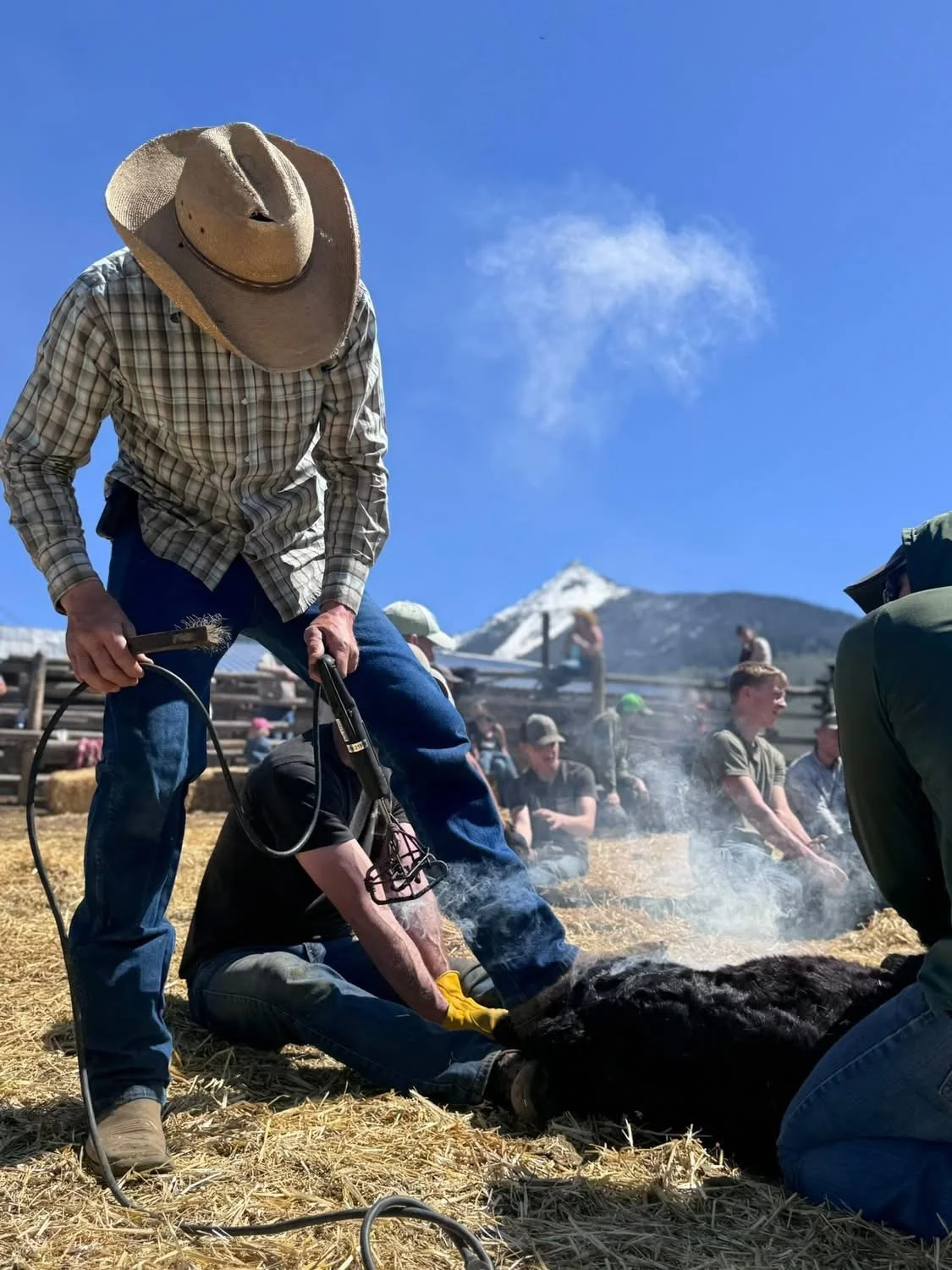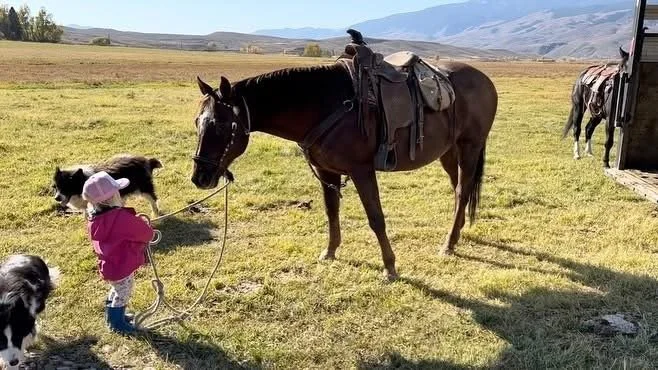By Ruth Jack
“Enthusiasm is common, endurance is rare.”
As a child growing up on a cattle ranch nestled in the Northeastern Idaho mountains, grit was a physical presence. Grit was the wind blowing dust and debris into my eyes, nose, and mouth. Grit was the ring around my ankles and between my toes when pulling off crusty socks. Grit was sand and dirt in every bite of a sandwich pulled from saddlebags during a long cattle drive. Grit was everywhere, covering everything, as persistent as the smell of fresh manure. It was washed off in freezing mountain streams during hot July summers and again in steaming showers at the end of long, hard days. What I didn’t know as a child was that this grit represented a resilient, determined, self-reliant character—built grain by grain, year by year—that Angela Duckworth (2018) would explore in her book, Grit.
This picture, and all the others, came from Ruth’s cattle farm!
Like its twin and namesake, this power of passion and perseverance settled like a blanket onto and into every part of my childhood. It sprouted and rooted inside of me like the trees in our apple orchard, nurtured every spring by hauling rocks off newly plowed fields, branding, and repairing fences. Summers were spent moving pipes across hundreds of acres of hay and grain fields too steep for automated irrigation, moving cattle across ranges, and more fencing. Fall brought second and third crops of swathing and bucking hay. Winter found us feeding cows and was punctuated by the calving season. Duckworth (2018) did not dedicate a chapter to calving in her book, but only because she has probably not been exposed to it. It is the embodiment of grit.
During the frigid months of February and March, family members take turns leaving our warm beds at 2 and 4 a.m. to make the rounds of the hundred head of cattle looking for birthing complications. Some nights, it's a quick 45-minute adventure. But when complications do arise, it becomes a night vigil of either patient competence or urgent, drastic, heroic measures to save the mother and baby (cow and calf)—the lifeblood of the entire operation, the reason why we work so hard all year. These baby calves are our purpose.
More important than the work itself was the certainty of principles drilled into us day after day. If the cows didn’t get fed, I didn’t get fed. If I broke something, I fixed it. If I wanted to eat bacon for breakfast or meat for dinner, I had to help slaughter, gut, cut, and package it. Birth and death, hope and despair, laughter and tears wove through life as cycles. I could hardly wait to graduate, leave for college, and buy milk, eggs, and frozen chicken breasts at the store. Fortunately, I found that although I could wash off the visible grit easily enough, the grit inside me was mine to keep and attracted experiences that fed and strengthened it.
Duckworth (2018) opens her book with the example of the rigorous West Point admissions process, which includes academic excellence, a Congressional nomination, and elite fitness scores. Despite this, one in five cadets drops out, many during the intense summer training called Beast. What makes some persist while others quit? Duckworth explores this question, which has also been asked by businesses and schools throughout the nation: are there measurable traits that predict success in tough situations? Army psychologists found that traditional metrics weren’t reliable, but Duckworth’s research identified grit—passion and perseverance—as the key predictor, measured on a grit scale.
Building on this idea of grit, Duckworth (2018) continued her research by examining participants in a national spelling bee. She found that the most successful spellers were not necessarily the most naturally gifted but those who practiced consistently and used effective study techniques—both key traits of grit. Duckworth expanded her research to include athletes, business leaders, musicians, and scientists, finding that long-term perseverance and passion were the common threads across disciplines. While other factors such as experience, a supportive teacher, or physical fitness influenced success, Duckworth’s studies show that, "when you compare people matched on these characteristics, grit still predicts success" (p. 12).
How does a person obtain and increase grit? First of all, it is not a perception or attitude. In one compelling study, Tsay (2016) found that people are more likely to attribute success to talent rather than to hard work, even though they claim to value hard work over talent. Could this be because it takes personal accountability out of the picture? If someone is a prodigy, it’s not something everyone can attain. Individuals would rather excuse their own lack of effort than recognize the amount of work it takes to be a virtuoso. We think we are either born with genius or not. When speaking of the Sistine Chapel, Michelangelo is credited with saying,
“If you knew how much work went into it, you wouldn’t call it genius.”
An estimated twenty to thirty percent of grit comes from genetic factors, which are shaped by the environment (Chabris et al., 2015; Wood et al., 2014). How we respond to this interaction—and, according to Duckworth, why we do so—is equally important. Mark Twain is attributed with saying, "The two most important days in your life are the day you are born and the day you find out why." Many young adults expect this epiphany to come instantaneously, but for most, it is a messy, long, criss-crossed process. How can you know what you love without first digging your hands into it, becoming invested, and working out some of the bugs? Sounds a bit like grit to me. To develop grit, you’ve got to be clear about your passion and purpose. However, becoming clear on passion takes perseverance. “Develop a habit of daily challenge-exceeding-skill practice. You can connect your work to a purpose beyond yourself. And you can learn to hope when all seems lost” (Duckworth, 2018, p. 269).
How to build perseverance? Duckworth suggests beginning young, when possible. “If you want to bring forth grit in your child, first ask how much passion and perseverance you have for your own life goals. Then ask yourself how likely it is that your approach to parenting encourages your child to emulate you” (p. 216). Allow children to struggle, to work through frustration and disappointment, to fail, to fall, and to rise up and do it again. From opening lids to getting dressed, to difficult projects, to losing at games, to being involved in challenging activities—while providing love, acceptance, and support. Many resources, such as Kennedy (2022) and Amen & Fay (2024), have books and workshops that specialize in teaching parents how to raise kids with grit. For Duckworth, much of it boils down to being involved in a pursuit or activity that is hard and sticking with it for several years.
A similar pattern of supportive and demanding leadership can mold businesses, teams, cohorts, etc., to develop a culture of grit by using tools such as “growth mindset, optimistic self-talk, and perseverance over adversity” (p. 192). Kyler and Moscicki (2024) describe a growth mindset as the ability to change attributes through effort, whether mental, physical, intellectual, or emotional, and cataloged 140 mindset traits. Research suggests we are malleable with time, perseverance, and motivation (Jiang et al., 2024). Like exercising a muscle, it takes grit to grow grit, and it is a lifelong process. “To learn is to die voluntarily and be born again, in great ways and small” (Peterson, 2017). To add cream to the custard, Duckworth and her team surveyed 2,000 American adults and found that grittier people are happier and more content with life choices (Young et al., 2015).
For anyone who has fallen, is tired, has met with disappointment, or is looking to grow personal grit, the following is a personally influential quote by Theodore Roosevelt (1910), which is also referenced in Duckworth’s book:
"It is not the critic who counts; not the man who points out how the strong man stumbles, or where the doer of deeds could have done them better. The credit belongs to the man who is actually in the arena, whose face is marred by dust and sweat and blood; who strives valiantly; who errs, who comes short again and again, because there is no effort without error and shortcoming; but who does actually strive to do the deeds; who knows great enthusiasms, the great devotions; who spends himself in a worthy cause; who at the best knows in the end the triumph of high achievement, and who at the worst, if he fails, at least fails while daring greatly, so that his place shall never be with those cold and timid souls who neither know victory nor defeat."
To take the grit test and get a grit score: https://angeladuckworth.com/grit-scale/
Learn more about ways to improve yourself in the personal growth module on the MyBestSelf101 website.
“Grit is living life like it’s a marathon, not a sprint.”
References
Amen, D. G., & Fay, C. (2024). Raising mentally strong kids: How to combine the power of neuroscience with love and logic to grow confident, kind, responsible, and resilient children and young adults. Tyndale House Publishers.
Chabris, C. F., Lee, J. J., Cesarini, D., Benjamin, D. J., & Laibson, D. I. (2015). The fourth law of behavior genetics. Current Directions in Psychological Science, 24(4), 304–312. https://doi.org/10.1177/0963721415580430
Duckworth, A. (2018). Grit: The power of passion and perseverance. Scribner.
Duckworth, A. L., & Quinn, P. D. (2009). Development and validation of the Short Grit Scale (Grit–S). Journal of Personality Assessment, 91(2), 166–174. https://doi.org/10.1080/00223890802634290
Jiang, X., Mueller, C. E., & Paley, N. (2024). A systematic review of growth mindset interventions targeting youth social–emotional outcomes. School Psychology Review, 53(3), 251–272. https://doi.org/10.1080/2372966X.2022.2151321
Kennedy, R. (2022). Good inside: A guide to becoming the parent you want to be. Harper Wave.
Kyler, E. N., & Moscicki, M. K. (2024). Measuring many mindsets: A systematic review of growth mindset domains, and discussion of domain relationships, with implications for growth mindset interventions. Social and Personality Psychology Compass, 18(11). https://doi.org/10.1111/spc3.70015
Goodreads. (n.d.). Quotes by Michelangelo Buonarroti. Goodreads. Retrieved from https://www.goodreads.com/quotes/176045-if-you-knew-how-much-work-went-into-it-you
Peterson, J. B. (2017, April 24). Ethics and free speech [Lecture]. Linfield College. https://www.youtube.com/watch?v=AKHuxVvA7T8
Roosevelt, T. (1910, April 23). Citizenship in a Republic [Speech]. Sorbonne, Paris, France.
Tsay, C.-J. (2016). Privileging naturals over strivers: The costs of the naturalness bias. Personality and Social Psychology Bulletin, 42(1), 47–61. https://doi.org/10.1177/0146167215611638
Wood, A. R., Esko, T., Yang, J., Vedantam, S., Pers, T. H., Gustafsson, S., ... & Frayling, T. M. (2014). Defining the role of common variation in the genomic and biological architecture of adult human height. Nature Genetics, 46(11), 1173–1186. https://doi.org/10.1038/ng.3097
Victoria Young, Yuchen Lin, and Angela L. Duckworth, "Associations between grit and subjective well-being in a large sample of U.S. adults," presented at the 16th Annual Convention of the Society for Personality and Social Psychology in Long Beach, CA, February 2015.




